Chapter: Nutrition and Diet Therapy: Carbohydrates
Classification of Carbohydrates
CLASSIFICATION
Carbohydrates are
divided into three groups: monosaccharides, disaccharides, and polysaccharides
(Table 4-1).
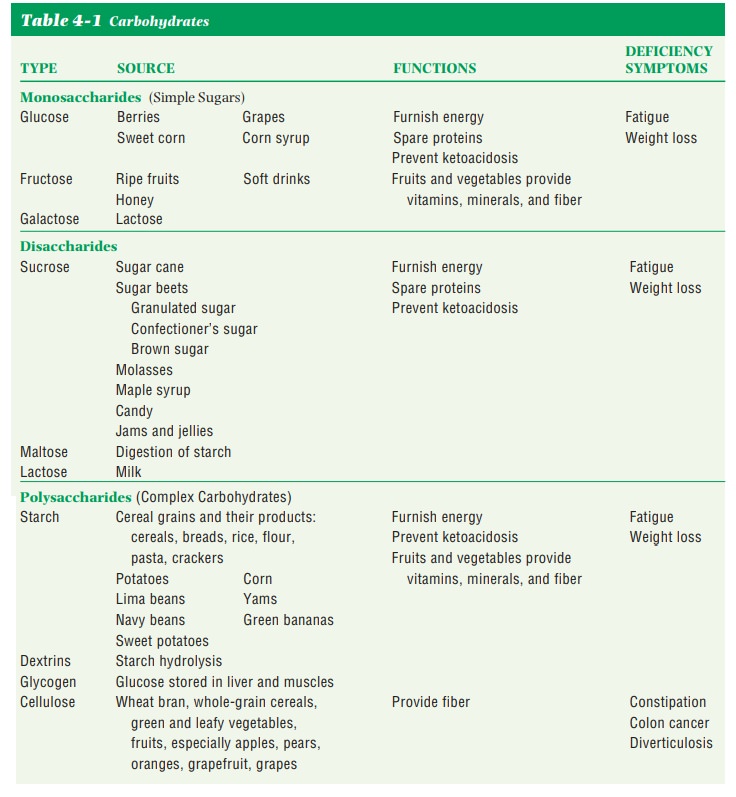
Monosaccharides
Monosaccharides are the simplest form
of carbohydrates. They are sweet,require no digestion, and can be absorbed
directly into the bloodstream from the small intestine. They include glucose,
fructose, and galactose.
Glucose, also called dextrose,
is the form of carbohydrate to which allother forms are converted for eventual
metabolism. It is found naturally in corn syrup and some fruits and vegetables.
The central nervous system, the red blood cells, and the brain use only glucose
as fuel; therefore, a continuous source is needed.
Fructose, also called levulose
or fruit sugar, is found with glucose inmany fruits and in honey. It is the
sweetest of all the monosaccharides.
Galactose is a product of the
digestion of milk. It is not found naturally.
Disaccharides
Disaccharides are pairs of the three
sugars just discussed. They are sweet andmust be changed to simple sugars by
hydrolysis before they can be absorbed. Disaccharides include sucrose, maltose,
and lactose.
Sucrose is composed of glucose
and fructose. It is the form of carbohy-drate present in granulated, powdered,
and brown sugar and in molasses. It is one of the sweetest and least expensive
sugars. Its sources are sugar cane, sugar beets, and the sap from maple trees.
Maltose is a disaccharide that
is an intermediary product in the hydro-lysis of starch. It is produced by
enzyme action during the digestion of starch in the body. It also is created during
the fermentation process that produces alcohol. It can be found in some infant
formulas, malt beverage products, and beer. It is considerably less sweet than
glucose or sucrose.
Lactose is the sugar found in
milk. It is distinct from most other sugarsbecause it is not found in plants.
It helps the body absorb calcium. Lactose is less sweet than monosaccharides or
other disaccharides.
Many adults are unable
to digest lactose and suffer from bloating, ab-dominal cramps, and diarrhea
after drinking milk or consuming a milk-based
This reaction is called lactose intolerance. It is caused by
insufficient lactase, the enzyme required for digestion of lactose. There are
special low-lactose milk products that can be used instead of regular milk.
Lactase-containing products are also available.
During the process of
making hard cheese, milk separates into curd (solid part from which hard cheese
is made) and whey (liquid part).
Lactose becomes part of the whey and not the curd. Therefore, lactose is not a
component of natural cheese. However, manufacturers can add milk or milk solids
to pro-cessed cheese, so it is important that persons who are lactose
intolerant check the labels on cheese products.
There is no test for
lactose intolerance. If eating dairy products consis-tently produces symptoms
of flatulence, diarrhea, and abdominal pain, the doctor may recommend
eliminating dairy products from the diet and adding them back after a period of
time to ascertain the client’s reaction. If the symp-toms persist, the client
is lactose intolerant.
Polysaccharides
Polysaccharides are commonly calledcomplex carbohydratesbecause they
arecompounds of many monosaccharides (simple sugars). Three polysaccharides are
important in nutrition: starch, glycogen, and fiber.
Starch is a polysaccharide
found in grains and vegetables. It is the stor-age form of glucose in plants.
Vegetables contain less starch than grains be-cause vegetables have a higher
moisture content. Legumes (dried beans and peas) are another important source
of starch as well as of dietary fiber and protein. Starches are more complex
than monosaccharides or disaccharides, and it takes the body longer to digest
them. Thus, they supply energy over a longer period of time. The starch in
grain is found mainly in the endosperm (center part of the
grain). This is the part from which white flour is made. The tough outer
covering of grain kernels is called the bran (Figure 4-3). The
bran is used in coarse cereals and whole wheat flour. The germ is the small-est part
of the grain and is a rich source of B vitamins, vitamin E, minerals, and
protein. Wheat germ is included in products made of whole wheat. It also can be
purchased and used in baked products or as an addition to breakfast cereals.
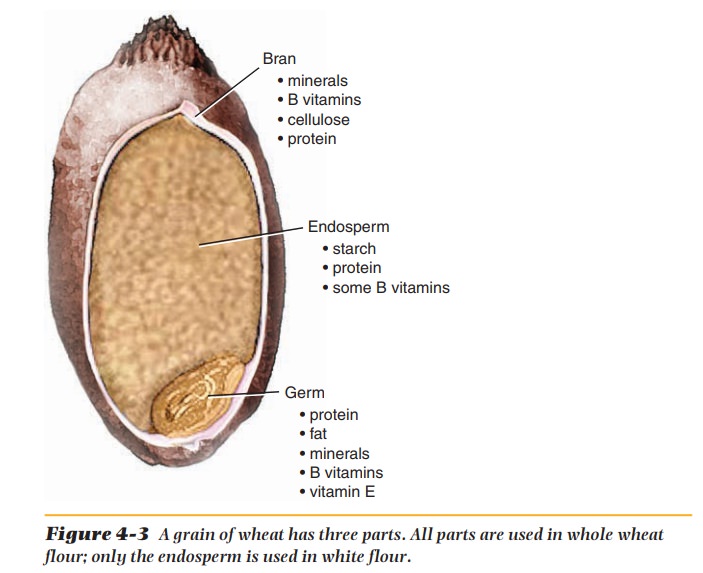
Before the starch in
grain can be used for food, the bran must be broken down. The heat and moisture
of cooking break this outer covering, making the food more flavorful and more
easily digested. Although bran itself is indi-gestible, it is important that
some be included in the diet because of the fiber it provides.
Glycogen is sometimes calledanimal starchbecause it is the
storageform of glucose in the body. In the healthy adult, approximately
one-half day’s supply of energy is stored as glycogen in the liver and muscles.
The hormone glucagon helps the liver
convert glycogen to glucose as needed for energy.
The Fibers.Dietary fiber,also called roughage, is indigestible becauseit cannot be broken down by digestive enzymes. Some fiber is insoluble (it does not readily dissolve in water), and some is soluble (it partially dissolves in water) (Figure 4-4). Insoluble fibers include cellulose, some hemicellu-lose, and lignins. Soluble fibers are gums, pectins, some hemicellulose, and mucilages.
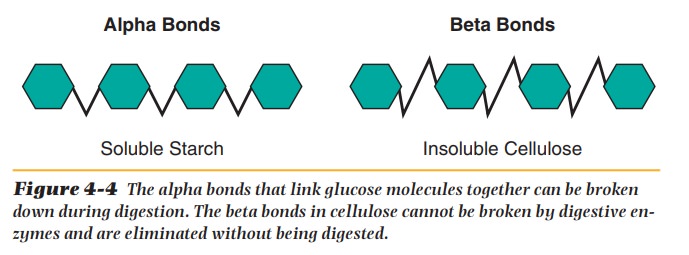
See Table
4-2 for food sources. Cellulose is a primary source
of di-etary fiber. It is found in the skins of fruits, the leaves and stems of
vegetables, and legumes. Highly processed foods such as white bread, pasta
(other than whole wheat), and pastries contain little if any cellulose because
it is removed during processing. Because humans cannot digest cellulose, it has
no energy value. It is useful because it provides bulk for the stool.
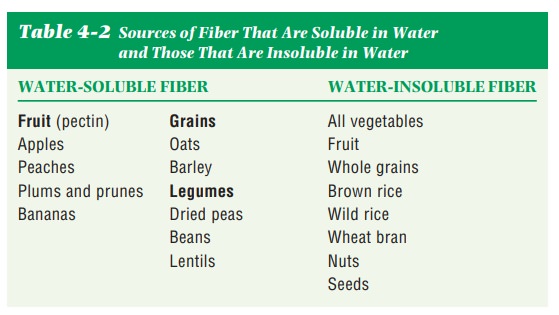
Hemicellulose is found mainly in
whole-grain cereal. Some hemicel-lulose is soluble; some is not. Lignins are the woody part of
vegetables such as carrots and asparagus or the small seeds of strawberries;
they are not a carbohydrate.
Pectin, some hemicellulose,
gums, and mucilage are soluble in
waterand form a gel that helps provide bulk for the intestines. They are useful
also be-cause they bind cholesterol, thus reducing the amount the blood can
absorb.
Fiber is considered helpful to clients with diabetes mellitus because it lowers blood glucose levels. It may prevent some colon cancers by moving waste materials through the colon faster than would normally be the case, thereby reducing the colon’s exposure time to potential carcinogens. Fiber helps prevent constipation, hemorrhoids, and diverticular disease by softening and increasing the size of the stool.
The optimal recommendation for fiber intake is 20 to 35 g/day. The normal U.S. diet is thought to contain approximately 11 grams. In general, Americans do not
consume sufficient amounts of fruits and vegetables. They should eat no fewer
than five servings of fruits and vegetables each day. Fi-ber intake should be
increased gradually and should be accompanied by an increased intake of water.
Eating too much fiber in a short time can produce discomfort, flatulence (abdominal gas), and
diarrhea. It also could obstruct the GI tract if intake exceeds 50 grams.
Insoluble fiber has binders (phytic acid or phytate), which are found in the
outer covering of grains and vegetables. These can prevent the absorption of
minerals such as calcium, iron, zinc, and magnesium, so excess intake should be
avoided. The type of fiber consumed should be from natural food sources rather
than from commercially prepared fiber products because the foods contain
vitamins, minerals, and phytochemi-cals as well as fiber. Table 4-3 lists the
dietary fiber content of selected foods.
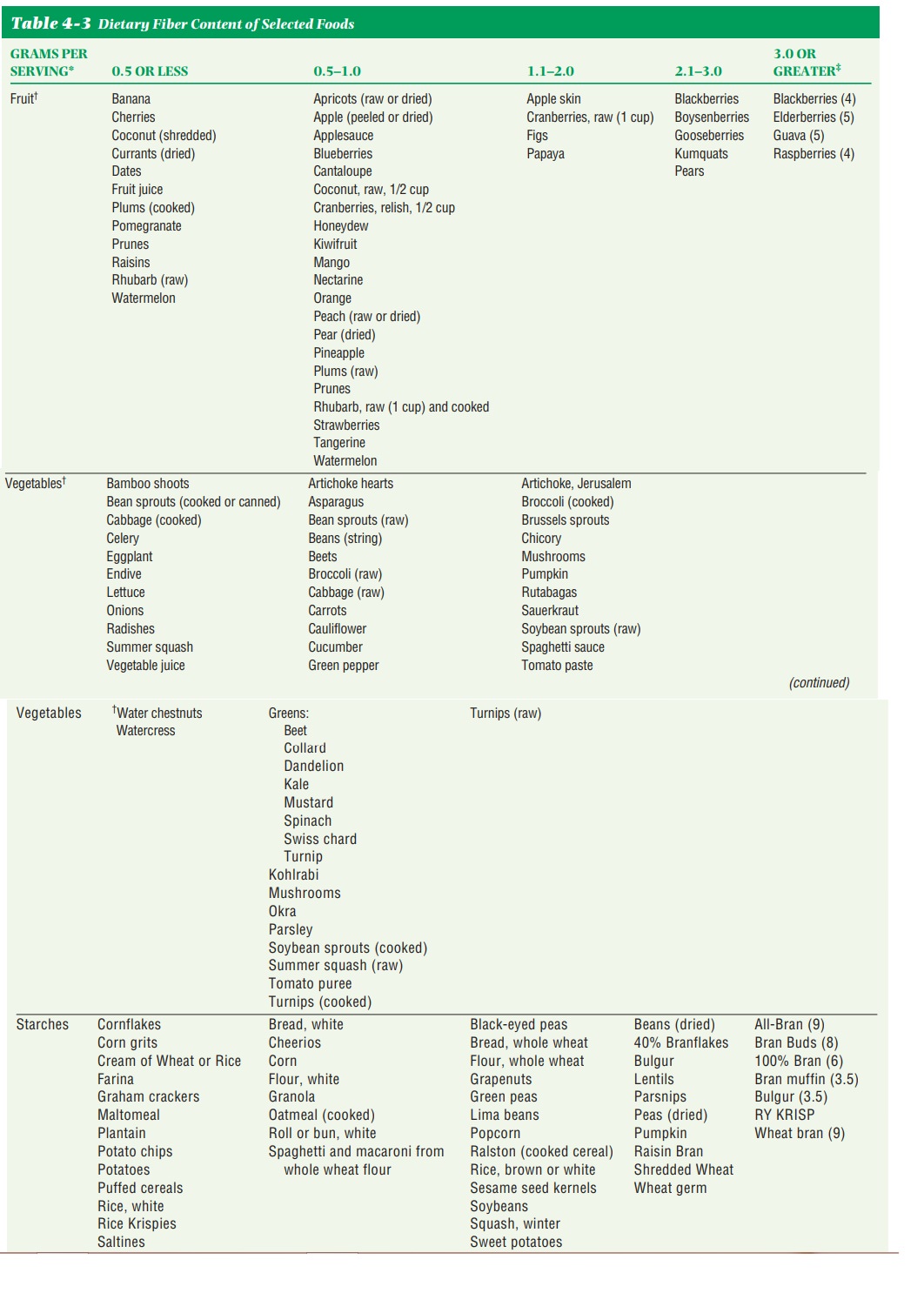
Related Topics